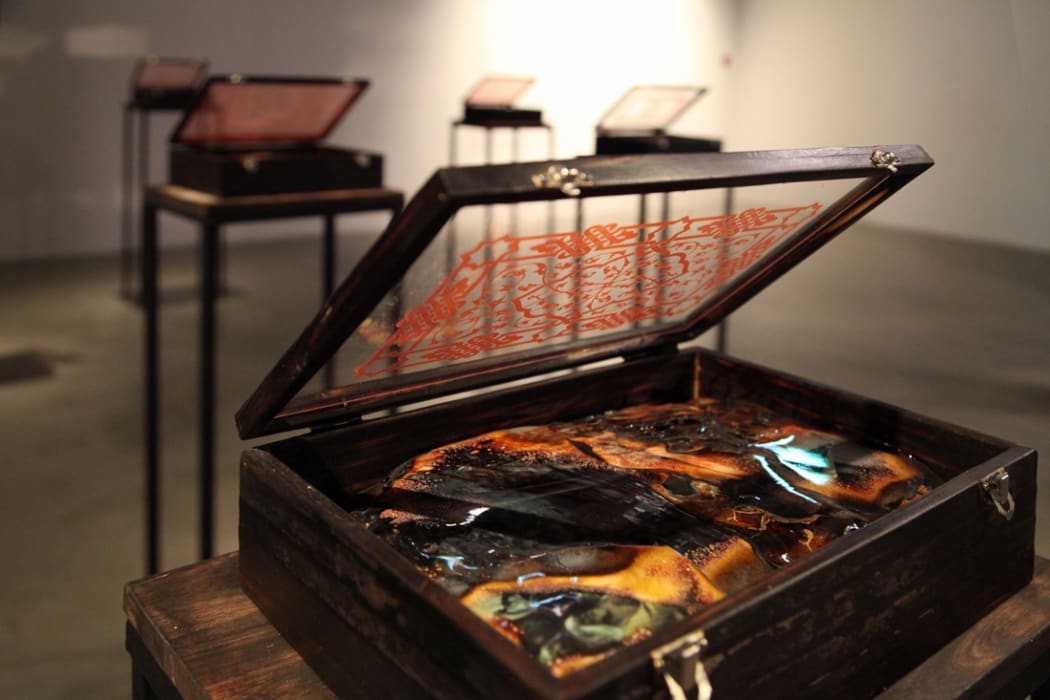
A small town, north-east of Mosul, Bashiqa was once known for its onion pickles and olive trees. With a population spanning Kurdish Yazidi, Shabak, Assyrian and Arab Muslim, there are records of a diverse community at the site from the 13th century; undoubtedly, Bashiqa’s history stretches back further still, and it remained a tourist destination for Iraqis into the 21st century.
Claimed by Kurdistan since the fall of Saddam Hussein in 2003 and under the control of the Iraqi federal government, longstanding territory disputes were followed by Islamic State occupation. Bashiqa was occupied by the terrorist organisation in 2014; two years later, following a conflict that saw much of the town destroyed and its population massacred or displaced, Bashiqa was liberated by Kurdish Peshmerga forces – and visited by a Kurdish artist.
Rushdi Anwar arrived in Bashiqa a month after its liberation in November 2016. Once, passage to the town would have taken around an hour. With roads decimated, Anwar’s journey took ‘six or seven’. Having arrived, he sought the town’s main church – or what remained of it – which had once been the centre of Bashiqa’s Christian community. Warned explicitly against touching anything in case of undetonated explosives, Anwar picked his way across the detritus and destruction that filled the centuries-old building. If he couldn’t sift through it by hand, at least he could document it with his camera.
Back in his Melbourne studio, Anwar began poring over his photographs and video recordings: rubble, soaring arches, metallic light boxes built to house the Stations of the Cross and a pile of clothes whispered to be from Bashiqa’s massacred inhabitants. The wreckage seemed to dictate its own mediation – ‘I thought about nice clean lightboxes, but I realised that that's not exactly what I saw or experienced. So I decided to create a different kind of box.’ We have found in the ashes what we have lost in the fire, as the work came to be titled, manifests the promise of that name in its form – comprised of a very different kind of box indeed.
Having been unable to take the church’s objects with him, Anwar decided to build them anew. With diligent reference to the site visit images, he crafted boxes based on Bashiqa’s – and, twelve wooden doppelgangers in hand, Anwar turned to their contents. What could such containers hold but their own ghosts? In the end, the artist did print his photos of Bashiqa’s church – not to display, but to destroy. A repetition, a recursion, a mirror image of their place of origin, Anwar filled his boxes with photographic remnants of their first incarnations.
Conceiving the devastation of Bashiqa and surrounding areas as definitively contemporary – a testament to our particular times – Anwar nonetheless reaches back into the past. The boxes which form the sculptural basis of We have found in the ashes what we lost in the fire are lidded with glass – ‘windows’ – upon which Anwar has superimposed the swirling, repetitious geometries synonymous with traditional Islamic art. ‘I came up with this idea about the window of the box. Okay, so what shall I do with that window?’
Back in the time of the Muslim conquests, when Muslim armies conquered parts of Spain, East and West collided in a way that changed both cultures forever. Amidst the violence and religious fervour on either side of the conflict, there emerged beauty too: food, music, architecture, the fusion of two worldviews with more in common than the battleground between them. ‘We’re talking about a long period, [from 711 to 1492]. It wasn’t always perfect, but in general, what happened was […] all kinds of religion and ethnicity melting together’.
Anwar notes Flamenco – from the Arabic felag mangu, meaning "fugitive peasant" with a root meaning "to flee" – as a stand out example of the colliding traditions, combining Jewish, African, Arab, European and Berber folk instruments for a sound as stirring today as it was in the Middle Ages. History is at its best when it makes mongrels, and the intermixing of different faiths has been happening – peacefully as well as by force – across the Middle East for millennia. It’s precisely that syncretism which would have placed a church in Bashiqa in the first place, at the heart of a town where locals of myriad belief systems had lived in relative harmony for hundreds of years.
‘We influence each other, regardless who we are. But it’s when things are politicised that those [shared] things disappear’, muses Anwar. And, while individual communities remain exemplary of cheek-by-jowl pleasantness across varied demographics, their leaders tend to prove less tolerant. Christian kings and Muslim califs, Islamic State fundamentalists and US presidents, have more in common than their mutually convenient hatred would allow them to imagine; with that crushing and rhythmic symmetry in mind, Anwar chose a vibrant orange for his intricate line patterns.
It’s a colour which gained notoriety at Guantanamo Bay, clothing prisoners of the United States in a facility renowned for torture and unimaginable living conditions. As such, it was no coincidence when Islamic State began forcing its victims to wear the same blaring jumpsuits in propaganda videos beamed around the world. ‘For me, it’s the colour of a new conflict’, says Anwar. Orange has taken on more layers of history and inference than most other colours in recent years – but of course, plenty of things are orange beyond penal uniforms.
Spices, flowers, desert sand, the lush gardens and glorious architecture of Al-Andalus where Islam and Christianity collided so many years ago. ‘It’s poetic’, says the artist of his approach to the project: a three-dimensional metaphor, crisscrossed with slant rhymes from past and present. In the ashes, that which was lost in the fire – literal infernos and ideological furnaces fertilise the earth almost as they parch it, more cycle than straight line.
By Emily Watkins